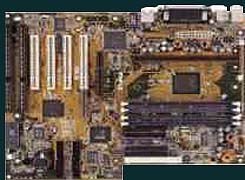Hardware
Audio
Controllers
General
Mainboards
Memory
Modems
Monitors
Portables
Printers
Processors
Scanners
Storage
Video
Games
Reviews
Previews
Cheats
& Hints
News
General Info
About
Us
Advertising
Awards
Contact
Us
Hot
Links
|
ASUS P2B-S Manufacturer
ASUStek
Expansion
Slot : 4/2/1
The
other member of the ASUS P2B family in this roundup is the big, bold ASUS
P2B-S, and I mean that "big" quite literally. It is also the other SCSI
motherboard mentioned in this roundup (together with the AOpen AX6B PlusÖyou
havenít forgotten, have you? It was only a few pages ago), and also uses
an Adaptec SCSI chipset. While the AOpen SCSI board used the Adaptec 7880
chipset (which supports UltraWide devices), the ASUS P2B-S has the Adaptec
7890 chipset and supports Ultra2Wide devices. You could say itís the higher-end
of the two SCSI boards being reviewed here today.
As
for the other stuff, you get no less than three SCSI ports; the 50-pin
SCSI-2 connector, the 68-pin UltraWide connector and the new 68-pin Ultra2Wide
connector. The BIOS gives you the option to boot from an external PCI SCSI
controller or the integrated SCSI controller itself. All cables come with
the board, documentation is extensive (and comprehensive) and all the ports
are labelled so they wonít get lost. ASUS mobos are known for quality and
this one is no exception. Like itís cousin the P2B-F, the P2B-S has no
truck with this modern notion of jumperless setups. Again like the former
board, the P2B-S is relentlessly stable and performance is definitely above-average,
even if (Iím sure you know this one by heart now, so repeat after me) the
performance differences in BX boards are virtually negligible. All in all,
a solid board and an extremely attractive choice if youíre in the market
for a SCSI board.
|
|
|
|
|

